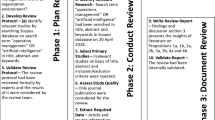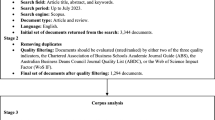Abstract
Coupled with the implementation of various e-health solutions, is an exponential increase in the quantity of data created, captured, stored and awaiting analysis. To maximize these valuable data assets as well as create reliable and trustworthy e-health solutions, a systematic and robust organising data framework is a strategic imperative. We introduce the Intelligent Performance Management(IPM) framework as a model to facilitate the systematic capture, analysis and then application of relevant data, pertinent information and germane knowledge that will in turn help to realise superior healthcare. In so doing, we focus on the clinical context of Total Hip and Knee Arthroplasty.



Similar content being viewed by others
References
Adler P, Riley P, Kwon S, Signer J, Lee B, Satrasala R. Performance improvement capability: keys to accelerating performance improvement in hospitals. Calif Manage Rev. 2003;45(2):12–33.
Ahern d, Kreslake J and Phalen J. ‘What is eHealth(6): perspectives on the evolution of eHealth Research. J Med Internet Res. 2006;8(1):e4. Available from http://www.jmir.org/2006/1/e4/ accessed Nov 2012.
Alonso G, Casati F, Kuno H, and Machiraju V. Web services: concepts, architectures, and applications. Springer Verlag; 2003.
Anand R, Graves SE, de Steiger RN, Davidson DC, Ryan P, Miller LN, et al. What is the benefit of introducing new hip and knee prostheses? J Bone Joint Surg Am. 2011;93 Suppl 3:51–4.
Arah OA, Klazinga NS, Delnoij DMJ, Tenasbroeka AHA, Custers T. Conceptual frameworks for health systems performance: a quest for effectiveness, quality, and improvement. Int J Qual Health Care. 2003;15(5):377–98.
Aynardi M, Jacovides CL, Huang R, Mortazavi SM, & Parvizi J. Risk factors for early mortality following modern total Hip Arthroplasty. J Arthroplast. 2012.
Baragoin C, Andersen C, Bayerl S, Bent G, Lee J, and Schommer C. Business Intelligence architecture overview. IBM. 2001.
Barrick I. Transforming health care management. Boston: Jones and Bartlett; 2009.
Beswick AD, Wylde V, Gooberman-Hill R, Blom A, & Dieppe P. What proportion of patients report long-term pain after total hip or knee replacement for osteoarthritis? A systematic review of prospective studies in unselected patients. BMJ Open. 2012;2(1).
Bhowmick S, Madria S, and Keong NW. Web data management. Springer. 2004.
Bourne RB, Chesworth BM, Davis AM, Mahomed NN, Charron KD. Patient satisfaction after total knee arthroplasty: who is satisfied and who is not? Clin Orthop Relat Res. 2010;468:57–63.
Buneman S. Semistructured data. Paper presented at the ACM on database systems; 1997.
Casati F, Shan E, Dayal U, Shan M-C. Business-oriented management of web services. Commun ACM. 2003;46(10).
Conroy JL et al. Risk factors for revision for early dislocation in total Hip Arthroplasty. J Arthroplasty. 2008;23(6):867.
De Marco M, Ricciardi F, van Brocke J. Strategies and solutions in eHealth: a literature review. In: Wickramasinghe N, editor. Critical issues for the development of sustainable E-health solutions. New York: Springer; 2012. p. 135–48.
Dijkman BA. Decision making open reduction/internal fixation versus arthroplasty for femoral neck fractures. Tech Orthop. 2008;23:288–95.
Dowsey MM et al. Economic burden of obesity in primary toal Knee Arthropalsty. Arthritis Care Res. 2011;63(10):1375–81.
Eckerson WW. Deploying dashboards and scorecards. TDWI report (pp. 5). TDWI; 2006.
Eckerson WW, and Howson C. Enterprise BI: strategies and technologies for deploying BI on an enterprise scale. Rep Excerpt. 2007;08/02/2011, from http://www.tdan.com/view-articles/4739.
Fayyad U, Piatetsky-Shapiro G, and Smyth P. From data mining to knowledge discovery in databases. 2008.
Gartner S. Data Integration identifies key usage trends. (2006):23–25.
Foran JR, Sheth NP, Ward SR, Della Valle CJ, Levine BR, Sporer SM, & Paprosky WG. Patient perception of physician reimbursement in elective total hip and Knee Arthroplasty. J Arthroplast. 2012.
Fortin P et al. Outcomes of total hip and knee replacement: preoperative functional status predicts outcomes at six months after surgery. Arthritis Rheum. 1999;42(8):1722–8.
Friend D. Healthcare.com: Rx for reform. Boca Raton: St Lucie Press; 2000.
Gold R, Stevenson D, Fryback G. HALYS AND QALYS AND DALYS, OH MY: similarities and differences in summary measures of population health. Annu Rev Public Health. 2002;23:115–34.
Graves S, Davidson D, de Steiger R, Ryan P, Griffith L, Miller L, Cashman K, Liu Y, and Stanford T. Hip and knee Arthroplasty. Annual report, Adelaide, Data Management and Analysis Centre and University of Adelaide; 2012.
Grembergen WV, Amelinckx I. “Measuring and managing ebusiness projects through the balanced scorecard”. Proceedings of the 35th Hawaii International Conference on System Sciences, HICSS. 2002: 258
Hartman CW, Ting NT, Moric M, Berger RA, Rosenberg AG, Della Valle CJ. Revision total knee arthroplasty for stiffness. J Arthroplasty. 2010;25(6):62–6.
Harvie P, Larkin J, Scaddan M, Longstaff LM, Sloan K, Beaver RJ. Stiffness after total knee arthroplasty: does component alignment differ in knees requiring manipulation?: A retrospective cohort study of 281 patients. J Arthroplasty. 2013;28(1):14–9.
HL7. 2012 www.HL7.org (accessed december 2012)
Holmboe ES, Weng W, Arnold GF, et al. The comprehensive care project: measuring physician performance in ambulatory practice. Health Serv Res. 2010;45:1912–33.
Holmes J, Abbott P, Cullen P, Moody L, Phillips K, Zupan B. Clinical data mining: who does it, and what do they do? AMIA. 2002;9(13).
Howson C. Success business intelligence. McGraw Hill; 2007
Hurst J, and Hughes MJ. Performance measurement and performance management in OECD health systems. OECD Labour Mark Soc Policy Occas. 2001;(47).
Kalakota R, and Robinson M. e-business 2.0: roadmap for success. Wesley; 2001.
Kaplan RS, Norton DP. The balanced scorecard: measures that drive performance. Harvard Bus Rev. 1992;70(1):71–9.
Kaplan RS, Norton DP. Measuring the strategic readiness of intangible assets. Harvard Bus Rev. 2004;82(2):52–63.
Kersten RF, Stevens M, van Raay JJ, Bulstra SK, van den Akker-Scheek I. Habitual physical activity after total knee replacement. Phys Ther. 2012;92(9):1109–16.
Kim GK, Mortazavi SM, Parvizi J, Purtill JJ. Revision for stiffness following TKA: a predictable procedure? Knee. 2012;19(4):332–4.
Kurtz S, Ong K, Lau E, et al. Projections of primary and revision hip and knee arthroplasty in the United States from 2005 to 2030. J Bone Joint Surg Am. 2007;89(4):780.
Marsden G, Kelly C, and Snell C. Selecting indicators for strategic performance management. Transp Res Rec: J Transp Res Board, 1956. 2006.
Martinsons M, Davison R, Tse D. The BSC: a foundation for the strategic management of information systems. Decis Support Syst. 1999;25(1):71–88.
McDougal CJ et al. Complications related to therapeutic anticoagulation in total Hip Arthroplasty. J Arthroplasty. 2013;28(1):187.
McGlynn EA, Asch SM, Adams J, Keesey J, Hicks J, DeCristofaro A, et al. The quality of health care delivered to adults in the United States. N Engl J Med. 2003;348:2635–45.
Miller W. “Hip and knee replacement.” Health Rep. 2002;(1):pp. 37–50. Oct 14.
Moghimi F, Wickramasinghe N. Improving e-performance management in healthcare using intelligent IT solutions. In: Wickramasinghe N, editor. Critical issues for the development of sustainable E-health solutions. New York: Springer; 2012. p. 3–16.
Moghimi FH, Wickramasinghe N, Zadeh H. “Incorporating intelligent risk detection to enable superior decision support in the orthopaedic operating room”. J Health Technol. 2011, forthcoming.
Nutley S, Smith PC. League tables for performance improvement in health care. J Health Serv Res Policy. 1998;31(1):50–7.
Pacifici G, Spreitzer M, Tantawi A, and Youssef A. Performance management for cluster based web services. IBM TJ Watson Research Center; 2003.
Perla RJ, Provost LP, Murray SK. The run chart: a simple analytical tool for learning from variation in healthcare processes. BMJ Qual Saf. 2011;20(1):46–51.
Porter M, Teisburg E. Redefining healthcare. Massachusetts: Harvard Business School Press; 2008.
Quintana JM, Escobar A, Aguirre U, Lafuente I, Arenaza JC. Predictors of health-related quality-of-life change after total hip arthroplasty. Clin Orthop Relat Res. 2009;467(11):2886–94.
Sanjay S, Wee K. Web data management. Springer; 2004.
Schaffer SP, Kim H. Responsive evaluation as a guide to design and implementation: case study of an e-health learning system. 2012;25(2):9–25.
Scheduling AEJ. A Strategic pathway for improved data Warehouse/Business intelligence performance. Advanced system concepts; 2010.
Schiavone Panni A, Cerciello S, Vasso M, Tartarone M. Stiffness in total knee arthroplasty. J Orthop Traumatol. 2009;10(3):111–8.
Singh JA, Jensen MR, Harmsen WS, Gabriel SE, Lewallen DG. Cardiac and thromboembolic complications and mortality in patients undergoing total hip and total knee arthroplasty. Ann Rheum Dis. 2011;70(12):2082–8.
Spil T, Stegwee R, and Teitink C. Business intelligence in healthcare organizations. Paper presented at the Proceedings of the 35th Hawaii International Conference on System Sciences, Hawaii, U.S.A.; 2002.
The Data Warehousing Institute (TDWI). TDWI survey. 2010. Retrieved 02/2011, 2011, from WWW.tdwi.org.
Vaughan S. Web services: beyond the hype. IEEE Comput. 2001;35:18–21.
Wagenmakers R, Stevens M, Groothoff JW, Zijlstra W, Bulstra SK, van Beveren J. Physical activity behavior of patients 1 year after primary total hip arthroplasty: a prospective multicenter cohort study. Phys Ther. 2011;91(3):373–80.
Wetters NG, Murray TG, Moric M, Sporer SM, Paprosky WG, & Della Valle CJ. Risk factors for dislocation after revision total hip arthroplasty. Clin Orthop Relat Res®. 2012;1–7.
Wickramasinghe. Achieving goal alignment with HElathcare knoweldge workers through ICT use. Melbourne: Heidleberg Press; 2007.
Wickramasinghe N, Geisler E, and Schaffer JL. Realising the value proposition for healthcare by incorporating KM strategies and data mining techniques with the use of information and communication technologies. Healthc Technol Manag. 2008a.
Wickramasinghe N, Bali R, Schaffer J. The Healthcare Intelligence Continuum: key model for enabling KM initiatives and realising the full potential of SMT in healthcare delivery. Biomed Eng Technol. 2008;1(4):415–26.
Wickramasinghe N, Bali R, Lehaney B, Schaffer J, Gibbons C. Healthcare knowledge management primer. New York: Routledge; 2009.
Wickramasinghe N, Blai R, Gibbons C Choi C and Schaffer J. Optimization of healthcare operations with knowledge management” in JHIMS summer 2009. 2009; vol 3 no. 4:pp 44–50.
Wickramasinghe N, Bali RK, Choi CJHJ, Schaffer JL. A systematic approach optimization of healthcare operations with knowledge management. USA: HIMSS; 2009.
Wickramasinghe N, Bali R, Kirn S, Sumoi R. Creating sustainable e-Health solutions. New York: Springer; 2012.
Wickramasinghe N, Al-harkim L, Gonzalez C, Tan J. Lean thinking for healthcare. New York: Springer; 2013. forthcoming.
Zhang W et al. OARSI recommendations for the management of hip and knee osteoarthritis Part III: changes in evidence following systematic cumulative update of research published through January 2009. Osteoarthritis Cartilage. 2010;18(2010):476–99.
Conflict of interest
The authors declare that they have no conflict of interest.
Author information
Authors and Affiliations
Corresponding author
Rights and permissions
About this article
Cite this article
Moghimi, F.H., De Steiger, R., Schaffer, J. et al. The benefits of adopting e-performance management techniques and strategies to facilitate superior healthcare delivery: the proffering of a conceptual framework for the context of Hip and Knee Arthroplasty. Health Technol. 3, 237–247 (2013). https://doi.org/10.1007/s12553-013-0057-4
Received:
Accepted:
Published:
Issue Date:
DOI: https://doi.org/10.1007/s12553-013-0057-4




